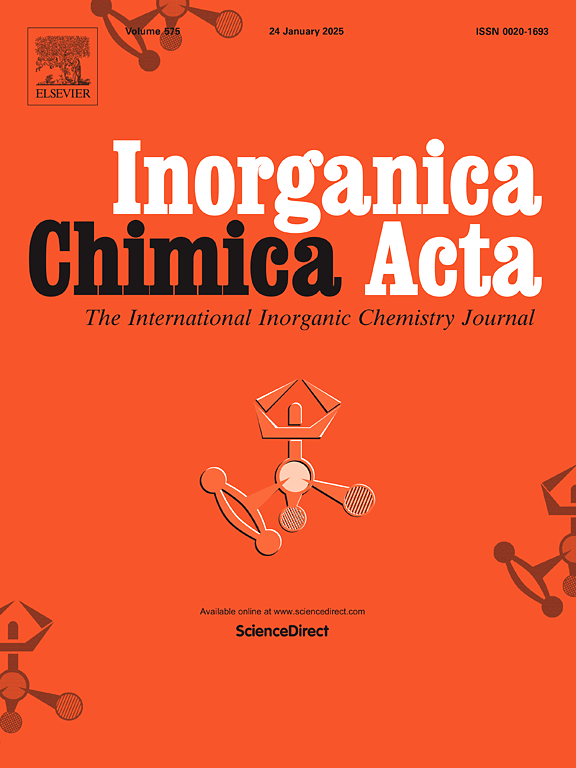Structural isomerism and π-extension effects in iridium(III) complexes: From green to deep-red emission tuning
IF 3.2
3区 化学
Q2 CHEMISTRY, INORGANIC & NUCLEAR
引用次数: 0
Abstract
In this study, Ir1 was synthesized using 2-(dibenzo[b,d]thiophen-2-yl)pyridine as the cyclometalating ligands (C^N) and 2,2,6,6-tetramethylheptane-3,5-dione (tmd) as the ancillary ligand. To achieve deep-red and near-infrared emission, the π-conjugation of the pyridine ring was systematically extended, leading to the design of four Ir(III) complexes (Ir1-Ir4) with emission wavelengths spanning from green to deep red (523–650 nm). Notably, π-extension in the N-containing moiety induced a significant red shift, while dibenzothiophene annulation at the C-moiety showed negligible effects. Furthermore, Ir2 and Ir3, as structural isomers, differ in the connection positions of dibenzothiophene and isoquinoline (C-1 vs. C-3). This variation in connectivity significantly influences the intramolecular electron distribution and the extent of π-conjugation. Differences in electron density and steric hindrance at the C-1 and C-3 positions likely alter the intramolecular charge transfer (ICT) and excited-state properties, resulting in a pronounced red shift of 55 nm in the phosphorescence emission peak of Ir3 compared to Ir2. DFT calculations revealed that pyridine ring π-conjugation effectively lowers LUMO energy and narrows the HOMO-LUMO gap, establishing a ligand design-photophysics correlation for targeted Ir(III) complex development.

铱(III)配合物中的结构同分异构和π扩展效应:从绿色到深红色的发射调谐
本研究以2-(二苯并[b,d]噻吩-2-基)吡啶为环金属化配体(C^N)和2,2,6,6-四甲基庚烷-3,5-二酮(tmd)为辅助配体合成了Ir1。为了实现深红色和近红外发射,系统地扩展了吡啶环的π共轭,设计了四个红外配合物(Ir1-Ir4),发射波长从绿色到深红色(523-650 nm)。值得注意的是,含n基团的π延伸引起了明显的红移,而二苯并噻吩环化在c基团上的影响可以忽略不计。此外,Ir2和Ir3作为结构异构体,在二苯并噻吩和异喹啉的连接位置上存在差异(C-1与C-3)。这种连通性的变化显著影响分子内电子分布和π共轭的程度。C-1和C-3位置的电子密度和空间位阻的差异可能改变了分子内电荷转移(ICT)和激发态性质,导致Ir3的磷光发射峰与Ir2相比明显红移55 nm。DFT计算表明,吡啶环π共轭有效地降低了LUMO能量,缩小了HOMO-LUMO间隙,建立了靶Ir(III)配合物发展的配体设计-光物理关联。
本文章由计算机程序翻译,如有差异,请以英文原文为准。
求助全文
约1分钟内获得全文
求助全文
来源期刊

Inorganica Chimica Acta
化学-无机化学与核化学
CiteScore
6.00
自引率
3.60%
发文量
440
审稿时长
35 days
期刊介绍:
Inorganica Chimica Acta is an established international forum for all aspects of advanced Inorganic Chemistry. Original papers of high scientific level and interest are published in the form of Articles and Reviews.
Topics covered include:
• chemistry of the main group elements and the d- and f-block metals, including the synthesis, characterization and reactivity of coordination, organometallic, biomimetic, supramolecular coordination compounds, including associated computational studies;
• synthesis, physico-chemical properties, applications of molecule-based nano-scaled clusters and nanomaterials designed using the principles of coordination chemistry, as well as coordination polymers (CPs), metal-organic frameworks (MOFs), metal-organic polyhedra (MPOs);
• reaction mechanisms and physico-chemical investigations computational studies of metalloenzymes and their models;
• applications of inorganic compounds, metallodrugs and molecule-based materials.
Papers composed primarily of structural reports will typically not be considered for publication.
 求助内容:
求助内容: 应助结果提醒方式:
应助结果提醒方式:


